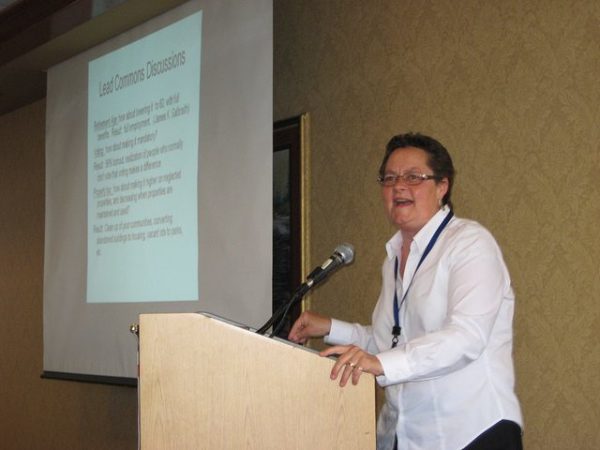
Editors’ Note: This feature is an excerpt from “Talking About Taxes,” which was published in the Fall 2010 edition of the Nonprofit Quarterly, “Philanthropy in a Recession.” We are pleased to once again present this important perspective from Kim Klein of Klein & Roth Consulting, which should make nonprofits consider their stake in the tax reform debate: What are they willing to push for, and what must they give up?
For another look at the potential impact of tax return, read this newswire on the Tax March rallies from April 15, 2017, in protest of President Donald Trump’s refusal to release his tax return history to public scrutiny.
I have been in fundraising for 35 years and have spent most of the past 20 years teaching, writing, and consulting with small nonprofits to help them build a broad donor base, or “grassroots fundraising.” When people ask whether I have proof that the fundraising methods I recommend work, particularly for social-justice organizations, I offer what I refer to as “poster children” in grassroots fundraising. Some of these groups are rural, some are in low-income urban neighborhoods, and others serve entire states.
Starting about 10 years ago and with the almost-exponential increases in more recent years, these same poster children began to call me saying, “We can’t raise as much money as we used to” or “Our fundraising isn’t working, and we can’t figure out why.” In turn, I try to figure out the problem: Do you have a new board that isn’t doing its job? Has the executive director burned out? Are you taking shortcuts with your donor relations? Sometimes I have identified the problems and worked with organizations to solve them.
But mostly I, along with many other grassroots fundraising experts, realized the real problem: starved of sufficient tax revenue, public agencies had moved into raising money from individuals, foundations, and corporations (i.e., the private sector), but the private sector simply doesn’t have enough money to do everything that it is called on to do while also paying for services that were previously funded publicly. Every day, donors face these mini-Hobson’s choices: “I’d like to give to my local theater, but I have to help my kid’s public school” or “I agree that we need to organize tenants, but right now I give my money to programs serving the homeless.”
So I started to be direct during my training sessions. “If you use these methods, you will raise more money. Still, it may not be enough, because without public funding for public services, without appropriate revenue created by fair and just tax policies, there simply isn’t enough money to do all that is demanded of the nonprofit sector.”
When I say this during my training, attendees look stunned. When the recession hit more than two years ago, cuts to nonprofits came fast and furious—not just from government but also from foundations. In response to cuts in funding, nonprofits reduced their budgets, essentially putting their own hands around their necks and slowly squeezing the life out of themselves.
The Nonprofit Tax Crisis
Nonprofits that rely on government funding to provide needed services have watched their funding shrink more and more while the cost of doing business and the need for their work increase. This situation has reached crisis proportions, with thousands of nonprofits laying off staff, cutting programs, and even going out of business altogether. The bottom line is that without significant restoration of government revenue, there is not enough money to do the work that communities count on nonprofits to do.
Compounding the problem is the fact that nonprofits (with few exceptions) have not taken a leadership role in advocating fair and just tax policies that can create a tax stream capable of maintaining a social safety net and an adequate quality of life. In the vast majority of states, and certainly nationally, there is no “nonprofit lobby.” Members of Congress do not look out their windows and think, “Oh, no, the nonprofit lobby is here.”
Social-service agencies have turned themselves into pretzels to meet increasing need with less funding. And the problem is that every time we try to do more work, help more people, and provide more services with the same amount—or often less—money, we say to the right wing, to the Grover Norquists of the world: “You were right. We didn’t need that much money to do our work.”
Still, most nonprofits don’t advocate revenue solutions to public-funding shortages. In my conversations with dozens of people about how we got into the mess, and why we have been very slow to figure a way out, I came up with four tactics for the nonprofit sector to stand up for itself and tackle the prevalent revenue shortages to work for the common good.
1. The nonprofit sector needs a unified identity and voice. The nonprofit sector does not have an identity of its own. While subsets of the sector—such as education, health care, seniors, and human rights—are clearly identified with their causes, these subsectors do little as a united front of “nonprofitness.” In contrast, the corporate sector has an identity and will advocate for itself. To be sure, subsets of the corporate sector—such as the oil, pharmaceutical, banking, and weapons industries—also lobby for themselves. But they also band together to make their needs known.
Members of the nonprofit sector need to come out of their silos and work together. Nonprofits that are not government funded need to recognize that they have just as big a stake in tax policy as those who are entirely government funded.
2. The nonprofit sector needs to learn about taxes. There is an appalling ignorance about issues concerning tax and budget structure among nonprofit staff. In my—admittedly not scientific but still fairly large—survey of nonprofit staff, few knew how their state budget structure worked, and few had opinions on issues such as what the estate tax should be or whether an increasing sales tax on alcohol and soda is a good thing or pushes an even greater tax burden onto poor people. (This may be true among the public at large as well.) In keeping with the overworked and beleaguered culture that prevails in nonprofits today, nonprofit staff members believe that there is little they can do to influence tax policy and therefore believe that it’s worthless to learn about taxes. There is a related unwillingness to stand up for our organizations and those we serve for fear of losing our tax status or further funding or out of an inability to budget the time.
3. The nonprofit sector needs to educate others on taxes. The organizations that work on and advocate improvements in tax policy tend to do so this way: “Here are a bunch of difficult-to-understand facts (which are mostly numbers), and here is what you should do: advocate for this, vote for that.” The problem with giving people a lot of information and then telling them to act on it is that no time has been spent in identifying what people think or feel to begin with. A Canadian activist once told me, “When American activists see a problem or injustice, they immediately say, ‘What shall we do? What shall we do?’ And they run around doing a lot, but much of it is ineffective, because they don’t stop to say, ‘What do I think about this? What do others think? Are my feelings and my thoughts different? Am I acting out of what I have been taught to think, or have I taken the time to create my own thinking? Whom can I talk with?’”
Sign up for our free newsletters
Subscribe to NPQ's newsletters to have our top stories delivered directly to your inbox.
By signing up, you agree to our privacy policy and terms of use, and to receive messages from NPQ and our partners.
We take great pride in saying that people have the right to their opinions, but people won’t form and vocalize opinions if their experience is that no one ever asks for their opinions.
4. The nonprofit sector needs to ask important questions. Organized philanthropy is no help, either. Recently, for example, the Giving Pledge received a good deal of praise. Led by Warren Buffett and Bill Gates, the program encourages wealthy people to give and pledge to give significant portions of their wealth and to encourage others to do so as well. Certainly we do not wish to disrespect enormous generosity, but the praise for this effort also needs to include a question: what kind of a dysfunctional society allows people to accumulate so much wealth in the first place? We see little advocacy concerning the estate tax, and large coalitions of nonprofits have opposed the proposal from President Barack Obama to cap deductions, even though 71 percent of Americans file a short form and receive no tax benefit for their giving.
To my knowledge—and I would love to be wrong—there is no major coalition of nonprofits that has asked about the purpose of taxes and why we have a tax system that redistributes massive wealth to fewer and fewer people. A few peeps of polite protest here and there won’t do the trick.
There is no easy solution to this complicated problem, but any solution must begin with educating ourselves and one another about the role of taxes in public life. Taxes are primarily a revenue tool, but they are also a mirror of community values. We need to make the connection between taxes and the common good. I agree with the economist Adam Smith, who asserted in the late 1700s that “the goal of taxes should be to remedy inequality as much as possible.”
Nonprofit Efforts for Tax Fairness
So what have nonprofits done about taxes? There are efforts under way in states from Alabama to Oregon to advocate for fair taxes and to organize others to do the same. The national coalition, the Tax Fairness Organizing Collaborative, spearheaded by United for a Fair Economy, for instance, has worked hard to establish effective national tax organizing infrastructure.
In California, the nonprofit sector, which comprises more than 160,000 organizations, employs 10 percent of the workforce, or about 1.3 million people, and is the second largest nonprofit workforce in the United States. The nonprofit sector has primary responsibility for providing programs that address poverty, hunger, homelessness, domestic violence, arts and culture, environmental protection and preservation, and the list goes on. Increasingly, nonprofit organizations partner with public schools, public parks, public-health departments, and prisons to help raise money and provide services that these entities no longer can because of budget cutbacks. Many nonprofits receive direct government funding to do their work, and all nonprofits benefit from tax policies designed to allow nonprofits to survive in a for-profit, free-market economy.
In a 2009 Council of Nonprofits survey on the effect of the recession on nonprofits, 58 percent of nonprofits reported an increase in the number of people needing services, with some reporting a doubling in demand. And 93 percent of those providing “lifeline” services experienced almost unmanageable increases. Almost all government-funded nonprofits report cutbacks, some of which are draconian in size and scope.
Nonprofits have been advised to create other income streams, develop a broad base of individual donors, and seek foundation funding. Many capacity builders have done their best to help nonprofits make this shift in their business model and their organizational culture, but we also know from studies and our own observation that private-sector funding (from foundations, corporations, and individuals) cannot replace government funding. Lester Salomon and other researchers have noted that since the Reagan tax cuts of the 1980s, the private sector is simply not large enough to replace government funding. And even if it were, is a democracy best served when so many programs and services are dependent on the largesse of private charity?
Show Me the Money
An example of tax fairness efforts by nonprofits is Show Me the Money, a project in California that combines the smarts, reach, and knowledge of the Building Movement Project, CompassPoint Nonprofit Services, the California Pan-Ethnic Health Network (along with a loose coalition of other agencies).The goal of Show Me the Money is to involve nonprofit staff in reform efforts to overhaul California’s tax and budget structure.
Over the next 20 months, Show Me the Money will engage nearly 10,000 nonprofit staff in thought-provoking presentations and discussions throughout California.?By February 2011, Show Me the Money will conduct four Train the Trainer sessions throughout California as well as workshops and conference presentations for nonprofit staff to reach approximately 3,000 staff. By significantly increasing training capacity, we expect to reach at least 7,000 additional people in 2011.
Show Me the Money aims to help nonprofit workers form their own opinions about tax and budget policy, to realize that they don’t have to be experts to understand how taxes work and to vote intelligently, to encourage them to continue conversations about taxes in their own networks, and to get involved in progressive local and statewide campaign efforts to reform our tax structure. On their own time, they can also support candidates that have a progressive tax agenda.
I am hopeful that coalitions in other states will want to work with the Building Movement Project in adapting this curriculum to their own state (or city, for that matter). The project is not expensive: it is volunteer driven, with volunteers doing the training, organizations voluntarily hosting them, and a lot of social media which take the campaign viral.
We are in the beginning stages, but I have great hopes for the project. While the recession has caused enormous suffering, it has also created one of the most important opportunities in my lifetime for promoting profound economic change. Today every economic assumption is up for grabs. People are talking about banking, regulation, compensation, the role of government, and the role of the corporate sector in a deep and thoughtful way, and they are asking fundamental questions.
Those of us in the progressive nonprofit sector need to get out in front of this “movement moment” and provide suggestions—and even answers—to the questions people have, and we must invite people to develop their own analysis. The right wing will happily provide simple, easy-to-understand answers, largely beginning and ending with a no-taxes frame. A simple, easy-to-understand beginning frame also begins and ends with the common good. Peter Maurin, a teacher of Dorothy Day who also founded the Catholic Worker Movement, said that our job is to “create a society in which it is easy to be good.” Such a society has many elements, but it presumes a commitment to a rough social equity that is partly achieved by a progressive tax system. The nonprofit sector is key to insisting on this, or it will be the primary victim of its absence. It is our choice, and it must be made quickly.











